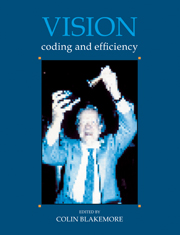Book contents
- Frontmatter
- Contents
- List of Contributors
- Preface
- Reply
- Acknowledgements
- Concepts of coding and efficiency
- Efficiency of the visual pathway
- Colour
- Brightness, adaptation and contrast
- Development of vision
- Depth and texture
- Motion
- From image to object
- 32 A theory about the functional role and synaptic mechanism of visual after-effects
- 33 Spatial and temporal summation in human vision
- 34 The efficiency of pictorial noise suppression in image processing
- 35 Algotecture of visual cortex
- 36 The iconic bottleneck and the tenuous link between early visual processing and perception
- 37 Pyramid algorithms for efficient vision
- 38 High level visual decision efficiencies
- Index
38 - High level visual decision efficiencies
Published online by Cambridge University Press: 05 May 2010
- Frontmatter
- Contents
- List of Contributors
- Preface
- Reply
- Acknowledgements
- Concepts of coding and efficiency
- Efficiency of the visual pathway
- Colour
- Brightness, adaptation and contrast
- Development of vision
- Depth and texture
- Motion
- From image to object
- 32 A theory about the functional role and synaptic mechanism of visual after-effects
- 33 Spatial and temporal summation in human vision
- 34 The efficiency of pictorial noise suppression in image processing
- 35 Algotecture of visual cortex
- 36 The iconic bottleneck and the tenuous link between early visual processing and perception
- 37 Pyramid algorithms for efficient vision
- 38 High level visual decision efficiencies
- Index
Summary
Introduction
It seems only fitting to begin this chapter with a quote from Horace Barlow (1980).
Our perceptions of the world around us are stable and reliable. Is this because the mechanisms that yield them are crude and insensitive, and thus immune to false responses? Or is it because a statistical censor who blocks unreliable messages intervenes between the signals from our sense organs and our knowledge of them? This question can be answered by measuring the efficiency with which statistical information is utilized in perception.
In this chapter, I describe some experiments done in the spirit of Barlow's suggestion. The results agree with his findings (1978, 1980) of very high human efficiency and are consistent with the view that humans can take a Bayesian approach to perceptual decisions. In this approach one combines a priori information (expectations) about what might be in the image and where together with image data. One does a detailed comparison (cross-correlation) of expectations with the new data and makes decisions based on a posteriori statistical probabilities (or likelihoods). This model gives a rather good explanation of human performance provided that one includes a number of limitations of the visual system. The efficiency method also allows one to investigate those sources of human inefficiency.
The experimental tasks all deal with high contrast signals in visual noise. The observer's task is therefore one of deciding whether one sees a signal in easily visible noise. The noise limits signal detection performance in a well known way and one can determine the best possible decision performance for the task.
- Type
- Chapter
- Information
- VisionCoding and Efficiency, pp. 431 - 440Publisher: Cambridge University PressPrint publication year: 1991
- 3
- Cited by



